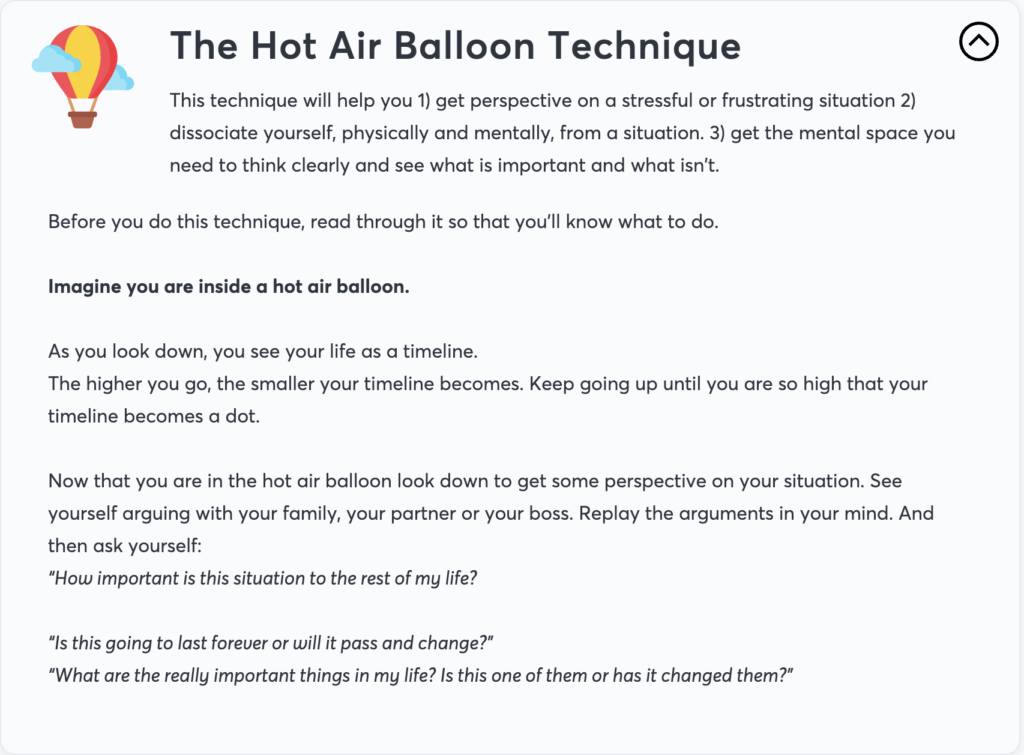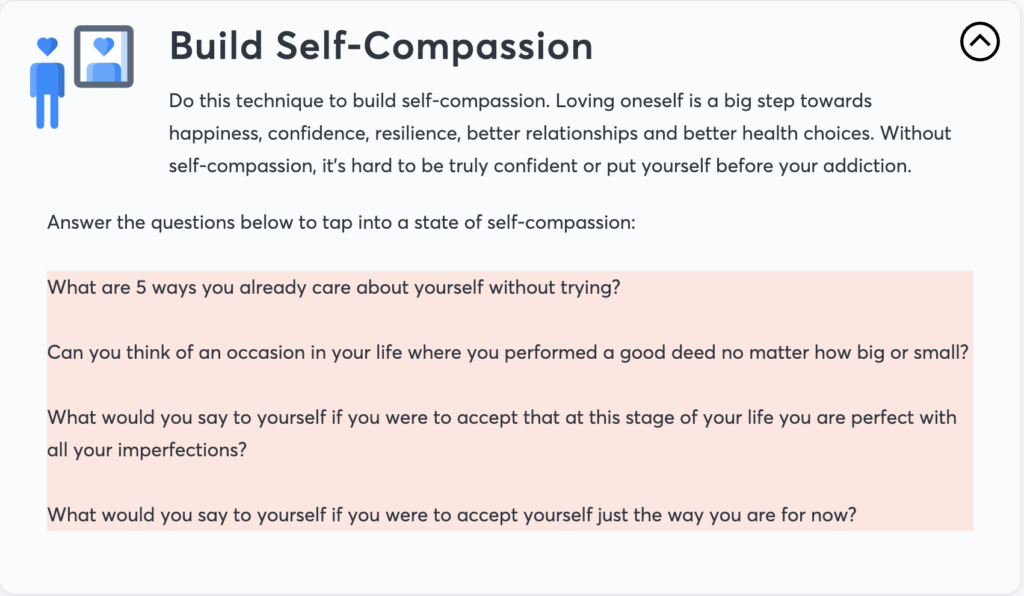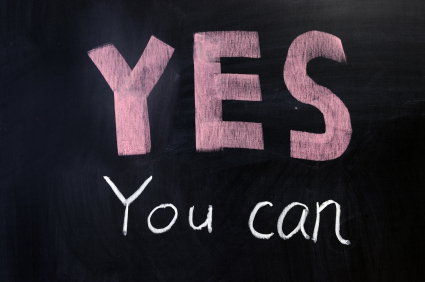Yes, of course!
1. Watch Day 8 of The CBQ Program
On Day 8 of the program, you’ll learn how to cope with stress and anxiety as a non-smoker.
You can access the day 8 videos here:
https://cbqmembers.com/modules/day8/
If you’re not there yet, you can use the tips below:
2. Watch this Video on Nicotine & Anxiety
3. Do Deep Breathing
When you smoke, you inhale deeply and slowly. So you feel relaxed thinking the cigarette helped. But in reality, it was the deep and slow breathing that relaxed you. Not the cigarette. You can see a step by step deep breathing exercise here:
https://s3-us-west-1.amazonaws.com/wellness-techniques-library/Breathe-it-Out.pdf

4. Do the “Hot Air Balloon” Technique
See the photo below:

5. Tune into Self-Compassion
Do this exercise:

6. Practice Gratitude
We can’t feel grateful and stressed at the same time.
This 4-step technique will help you feel happier, present, and beat negative emotions, thoughts, and cravings. The more you do this exercise, the more you will increase your happiness.
Step 1. Rate your stress levels
Rate how stressed, anxious, worried or angry you feel, on a scale from 1 to 10. 1 for “relaxed”, and 10 for “I’m freaking out. I need a cigarette now”. This is important because at the end of this technique we want to see how much you have reduced your stress.
Step 2. Focus on what you have
Close your eyes and begin to focus on something that you have in your life right now. Something that you feel a genuine sense of appreciation for.
If you allowed yourself to be grateful for something, what could it be?
Start by looking at the small things in your life- someone holding the door for you, a conversation with a stranger, a child’s innocent smile, a beautiful day, the fact that you are alive and can see, walk, talk and feel!
As you go on, focus on the bigger things you’re thankful for in your life. It can be your family, friends, work, your home, or an adversity you were able to overcome.
After spending a few minutes on this step, move on to step 3.
Step 3. Write 3 things you are grateful for
Take a piece of paper, a notes app on your phone or a notebook and write 3 things you are grateful for.
(It doesn’t matter how many things you thought about during step 2. Just select 3 and write them down.)
For example:
I am thankful for…
I appreciate…
In my life, I am grateful I have…
Later you may want to expand and write why you are thankful for those things.
Tip: Writing will help you keep your hands busy so you can avoid smoking.
Step 4. Rate your stress levels again
Stop and check. On a scale from 1 to 10, how stressed do you feel now?

Why Practicing Gratitude Decreases Stress & Negative Emotions
1. Gratitude makes you happier.
In a study, scientists asked a group of people to keep a daily journal of all the things they were grateful for. And they asked another group to record all the things that annoyed them.
And guess what?! The people who wrote down the things they were grateful for were MUCH happier, determined, enthusiastic, and energetic than the group of people who were focused on the negative aspects of their lives.
2. You cannot feel grateful and stressed, depressed or angry at the same time.
It is practically impossible! Also, while feeling grateful you can’t feel depressed, cranky, or angry- which are common when stopping smoking. We can’t experience negative feelings when we feel grateful. Doesn’t happen.
Your stress is like a small child that’s easily distracted. When a child cries and you give them a toy, they will get distracted and stop crying. The same way, gratitude is like a toy that will instantly end any negative thought.
You can also watch this video:
7. Overcome Negative Thinking that Causes You to Feel Stressed
This cognitive restructuring technique will help you reduce and challenge negative thinking.
Do it when you feel very worried, anxious or irritated about a particular issue. It will help you keep your negative thinking at bay and come up with a plan.
1. What is the catastrophe/problem that I am worried about?
Clearly state: “what am I worried will happen?”
Change any “what if … ?” statements into clear predictions about what you fear will happen. e.g., What if something bad happens? (wrong, too general). I will never get any money (correct, specific).
Rate how awful you believe this problem will be (1-100%)
2. How likely is this event to happen?
Has anything this bad ever happened to me before? How often does this kind of thing happen to me? Realistically, is this likely to happen now?
e.g., Unlikely- I’ve been able to support myself so far. I have always been able to find a solution.
3. How awful would it be if this did happen?
What is the worst-case scenario? What is the best-case scenario? What would a friend say to me about my worry?
e.g., It would be bad if it did happen – I would have to give up my hobbies, and I would struggle to look after my family. The best case scenario is that my husband and I might be able to find a way to manage.

4. Just supposing the worst did happen, what would I do to cope?
Has anything similar happened before? How did I cope then? Who could help me get through it? What resources, skills, or abilities would be helpful to me if it did happen?
e.g., We coped when we had problems before. We got help from family.
5. What positive and reassuring thing can I say to myself about my problem now?
What would make me feel safer?
e.g., It’s scary not having enough money, but what I’m afraid of is unlikely to happen. Things never stay at their worst forever.
6. Come up with 3 positive alternative statements.
e.g., 1. My financial problems will probably be solved. The most important thing is having my health and my family.
2. I’m at my worst now – things are likely to get better than this.
3. Even while I’m having these difficulties, I’m still able to do some of the things I enjoy.
Rate again how awful you believe now this problem will be (0-100%)
8. Try Color Breathing
Color breathing is a form of meditation where you imagine yourself inhaling and exhaling a color. You can do it when feeling tense or before you sleep.

Before you do this exercise, read through it so that you know what to do.
Step 1: Sit back in a comfortable position or lie down.
Step 2: Allow your attention to focus on your body. If your mind begins to wander, bring your attention back to the color you’re breathing in.
Step 3: Put your hands over your stomach, palms down, with your fingers crossed just above your belly button.
Take a deep breath through your nose, and feel your stomach pushing your fingers towards the other side of the room.
Breathe all the way out from your mouth until there’s no air in your lungs.
Keep breathing in and out.
Step 4: Now imagine a color that makes you feel peaceful. Imagine this color in the form of a cloud, a light, or a mist. Imagine it all around you. (If it’s hard to imagine a color just imagine something that is that color: blue sky, white clouds, green forest, pink flamingo, red tulip.)
Step 5: While breathing deeply and slowly, notice how you start breathing in your color. Imagine it flowing from your nose to your chest and imagine it flowing to every part of your body.
Notice how your feet feel when the color passes through them.
Notice how your legs feel.
Notice how your abdomen feels.
Now turn your attention to your chest and notice your color slowly overflowing your hands, your throat and your head all the way through the top.
Step 6: Imagine your color shining through you and bathing your body and mind.
Step 7: Whenever you’re ready, open your eyes, look around, take a deep breath and enjoy the calm.
9. Relax with Mindfulness
This exercise will help you take your attention away from smoking without willpower.
Step 1. Sit comfortably.
Step 2. Put a timer for 5 minutes if you can.
Step 3. Imagine time is slowing down around you, and everyone and everything is moving in slow motion.
Step 4. Focus on your surroundings. Observe without judgment, and do not try to control or follow your thoughts. If your mind wanders, bring your attention back to your surroundings.
Focus on what you can see? What colors, textures, and patterns can you see around you?
What can you hear? Are there any humming, subtle, or louder noises you can hear?
What do you smell? Is there a smell in the air? How does the room smell? How do you smell?
Step 5. Then turn your focus inwards. How is your breathing? Fast or slow? How does your body feel?
Observe without judgment, and do not try to control or follow your thoughts. If your mind wanders, bring your attention back to your body.
Keep on going until the craving goes away.

Why it Works
Mindfulness is the basic human ability to be fully present, aware of where we are and what we’re doing, and not overly reactive or overwhelmed by what’s going on around us. (source: https://www.mindful.org/)
We have so many things going on in our lives that we forget to experience and appreciate the present moment.
We think a lot about the past and the future, but what about the now?
Mindfulness is something all of us can do and can help us:
- Reduce stress
- Improve concentration
- Increase self-control
- Reduce smoking by 60%*
- *(Research by the University of Oregon https://www.sciencedaily.com/releases/2013/08/130805152418.htm)
To practice mindfulness, start by focusing on one thing right now. That thing can be your breath, what you hear, what you feel or a mantra. In that sense, mindfulness is a part of prayer or meditation.
10. Do The YES Exercise (Requires movement)
This exercise will help you escape a bad emotional state and feel good.

Think of your emotional state as a light bulb. A light bulb needs energy and electricity to light up. Right? The same way you need the energy to turn on a bright and vivid emotional state.
And this power comes from your body. Your body is a source of energy that you can use to change your emotional state. Because emotions come from within, and you have the power to change how you feel.
So to escape from a bad emotional state, you have to change your physiology.
Okay, let’s do it.
Stand up now, take your hands, and clap them together.
Yes, do this now.
Then open your chest and look up saying YESYESYESYESYESYESYESYESYES repeatedly.
Put a big smile on your face.
Jump a little bit and feel the movement of air through your chest, throat, and mouth.
How do you feel now?
Excited?
That’s the state you should put yourself in.
And the more you do it, the easier it will be for you to get there!
You can opt-in to powerful states just by changing your posture, breathing, movement, and facial expressions. And if you do this repeatedly, it will become a habit.

Why it Works
You can change your emotions by changing your physiology.
If you walk around like you’re tired, you will feel tired.
Your emotions affect your body, and your body affects your emotions.
For example, do you have the same facial expressions when you feel joy and desperation? No. Your muscles stretch differently. Even the temperature of your body is different.
And how does someone who feels depressed positions their body? Is it the same as when you feel excited and powerful?
Try something with me for a second.
If you are standing up, sit down.
Pretend you are skeptical and depressed. Look down.
Raise your shoulders and turn them inwards.
Notice how that feels.
How is your breathing? Slow and shallow?
Lower your voice and talk slow.
How do you feel your face?
How do you feel inside you?
Horrible!
So now, let’s snap out of it!
Now! Stand up, take your hands, and clap them together. Open your chest and look up saying YESYESYESYESYESYESYESYESYES repeatedly. Put a big smile on your face. Jump a little bit and feel the movement of air through your chest, throat, and mouth.
How do you feel now? Excited?
That’s the state you should put yourself in. And the more you do it, the easier it will be for you to get there!
You can opt-in to powerful states just by changing your posture, breathing, movement, and facial expressions. And if you do this repeatedly, it will become a habit.
I encourage you to commit, for the next seven days, and spend one minute, twice a day, doing the YES exercise.
Will it feel silly? Probably, But remember: By practicing this exercise, you will be training your body and hard-wiring your mind to opt into good states. That neurological programming will stick with you, so do it and make it fun.
11. Put Your Thoughts on Trial
We all have unhelpful, distressing, or negative thoughts and beliefs. When our thoughts and emotions become overwhelming, it helps to put them on trial.
In this exercise, you will be the defense attorney, prosecutor, and judge, and you will compare the evidence against 1 distressing thought.

You will only present verifiable facts to test the accuracy of that thought, not opinions, past references, or suspicions.
Prepare
What is the main thing that’s upsetting me? What about that upsets me? What is the worst that I believe could happen? What would that mean or say about me or the situation?
Accused
What is the 1 thought that’s on trial?
Defense
What evidence is there that supports this thought? What hard, undeniable facts verify that this thought is true?
Prosecution
What evidence tells you that this thought is untrue? What would others say when asked to give evidence against this thought?
Judge’s Verdict
Is the thought accurate and fair? Are there other thoughts that could explain the facts?
Based on the evidence, create a closing statement about this thought. Your statement needs to be balanced and realistic.
Why it Works
Putting your thoughts on trial helps you cut through the emotional thinking and look for facts that support or contradict the distressing thought. That way, you will identify irrational thoughts and be able to make better decisions.
12. Write it Out For Negative Emotions

This writing technique will decrease feelings of anxiety, anger, and depression. Before you do this technique, read through each step so that you know what to do.
Step 1: Rate your stress/anger/depression/worry levels on a scale of 1 to 10.
1 for “Not at all” and 10 for “Extremely”. Use this technique only if your emotions are at a level 6 and above.
Step 2: Grab a pen and a piece of paper and start describing your stress/anger/depression/worry.
What is causing you to feel the way you do right now? How do you know that’s accurate?
What is great about this problem? What could you learn from it?
What are you willing to do to fix it? What are you NOT willing to do to fix it? When will you start?
Step 3: Stop and check.
On a scale of 1 to 10, how intense is your stress/anger/depression/worry now?
Step 4: Plan.
If you are not at level 4 or below, please write 3 things you are missing to get there. 1._______ 2. _______ 3. _______.
Step 5: Act.
What is the smallest first step you can take towards achieving 1.______? When will you do it?
Why it Works
Have you ever felt really anxious, sad, angry or overwhelmed by something… but then talked to a friend about it and felt better?
Or have you ever been very frustrated with someone and after writing them an angry email or text and articulating your frustration… you felt calmer and more relaxed?
When you express a problem, concern or feeling, you take it off of your mind.
In other words, you transfer it from your head to another person, your phone or a piece of paper.
This transferring process makes problems less overwhelming.
13. The Movie Exercise
The Movie exercise will help you change the way you experience 1) a negative memory you keep replaying in your head 2) an event or scenario that makes you angry.

Before you do this technique, read through each step so that you know what to do.
1. Sit comfortably and relax.
2. Imagine you are in a cinema. The cinema is empty, and you’re sitting in a seat near the middle looking at a huge screen. It’s comfortable, and you feel relaxed and safe.
3. The movie is frozen on the first frame. That first frame looks like a black & white photo in which you can see yourself. In a little while, you are going to watch a movie of the memory or event that (habitually) makes you angry. There won’t be any sound. Instead, there will be the soundtrack from Muppets Show or any other funny show you like.
4. Now imagine you are floating out of your body into the projection booth. You can see yourself sitting in the cinema looking at the screen. You can see the back of your head and shoulders. Notice what color shirt you are wearing down in that seat.
5. Now, turn that ill frame into a black & white movie that shows this memory or event that causes you to be angry. Watch yourself watching yourself on the screen experiencing this event.
6. When you get past what is the worst of this experience stop the film and freeze it in the last frame.
7. Float inside the movie and view everything through your own eyes. Now run the movie at high speed backward, in color and with you in it.
You will see everything happening in reverse; people and things will walk, talk and move backward. The same soundtrack will play backward at top speed, and the whole movie will be over quickly.
8. When you reach the beginning of the movie black out the screen.
9. Repeat steps 5-8 until you don’t experience anger/frustration/irritation anymore.
Test
Can you think of an event in the past, an event which if you’d thought about it previously would have caused you to be angry and notice how it’s different now?
Future Pace
Can you think of an event in the future, an event which if it had happened in the past would have caused you to be angry and notice how it’s different now?
Why it works
The way we feel in any given situation has to do with how we experience that situation.
Each of us has a unique perspective on life, people, and specific situations. So we experience and react to things differently.
Let’s take Sally and Beth as an example. Sally gets frustrated when her husband interrupts her. Beth does not. Why is that? (keeping in mind that nobody likes being interrupted)
When Beth gets interrupted, she says to herself “It’s ok, he didn’t mean it,” and she focuses on all the great things her husband does for her. That’s why she can maintain a good state.
On the other hand, when Sally gets interrupted, she thinks “Why does he do this all the time?” or “He doesn’t respect me” and she remembers similar situations where the same thing happened in the past. That’s why she gets frustrated.
As you can see, Sally does get angry because of her husband, but because of the way she interprets his behavior.
The way we experience and interpret a situation dictates our feelings and behavior. And by changing our perception of a situation, we can easily change the emotions and behaviors related to it.
14. Fly On the Wall Technique
The Fly On the Wall Technique will help you overcome negative thinking and focus on the positive aspects of your life (even when this seems hard)

Imagine you are a fly on your wall, looking at yourself and your life.
- What are 3 positive aspects you can notice? (For example, it can be the work you do, the people you have around you, what people say about you or something positive that happened recently).
- What do you enjoy?
- What’s important to you?
- What can you admire about yourself?
- What is there for you to learn?
